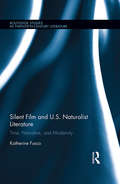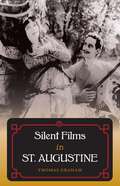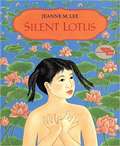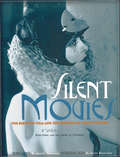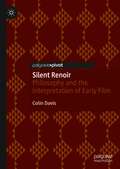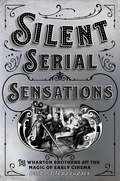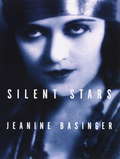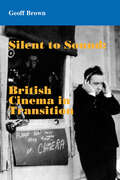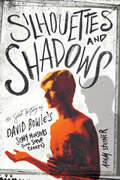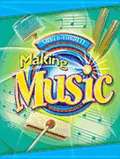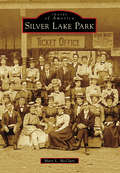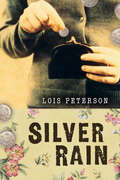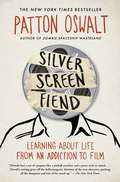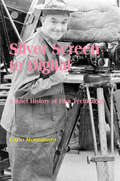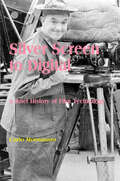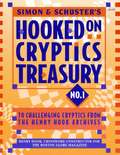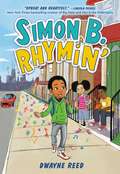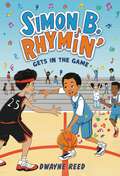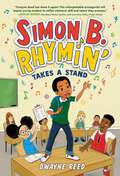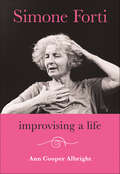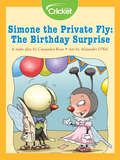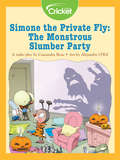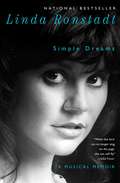- Table View
- List View
Silent Film and U.S. Naturalist Literature: Time, Narrative, and Modernity (Routledge Studies in Twentieth-Century Literature)
by Katherine FuscoTypically, studies of early cinema’s relation to literature have focused on the interactions between film and modernism. When film first emerged, however, it was naturalism, not modernism, competing for the American public’s attention. In this media ecosystem, the cinema appeared alongside the works of authors including Charlotte Perkins Gilman, Jack London, and Frank Norris. Drawing on contemporaneous theories of time and modernity as well as recent scholarship on film, narrative, and naturalism, this book moves beyond traditional adaptation studies approaches to argue that both naturalism and the early cinema intervened in the era’s varying experiments with temporality and time management. Specifically, it shows that American naturalist novels are constructed around a sustained formal and thematic interrogation of the relationship between human freedom and temporal inexorability and that the early cinema developed its norms in the context of naturalist experiments with time. The book identifies the silent cinema and naturalist novel’s shared privileging of narrative progress over character development as a symbolic solution to social and aesthetic concerns ranging from systems of representation, to historiography, labor reform, miscegenation, and birth control. This volume thus establishes the dynamic exchange between silent film and naturalism, arguing that in the products of this exchange, personality figures as excess bogging down otherwise efficient narratives of progress. Considering naturalist authors and a diverse range of early film genres, this is the first book-length study of the reciprocal media exchanges that took place when the cinema was new. It will be a valuable resource to those with interests in Adaptation Studies, American Literature, Film History, Literary Naturalism, Modernism, and Narrative Theory.
Silent Films in St. Augustine
by Thomas Graham“This absorbing tale, documenting the forgotten history of early moviemaking in St. Augustine, is a must-read for film enthusiasts.”—Janelle Blankenship , coeditor of European Visions: Small Cinemas in Transition “Very few people have any idea that St. Augustine played any role in early film history. This book brings St. Augustine into a much larger film conversation.”—Christina Lane, author of Magnolia “This richly detailed book tells the story of early filmmakers’ adventures in St. Augustine and captures the excitement of their moviemaking escapades.”—Kathryn Fuller-Seeley, coauthor of One Thousand Nights at the Movies: An Illustrated History of Motion Pictures, 1895–1915 “Given that the great majority of these early films are now lost, Graham makes an important contribution to the study of Florida’s image on film.”—Jan-Christopher Horak, author of Saul Bass: Anatomy of Film Design “The ‘reel’ history of Florida and its contribution to the development of American film history has been left out of mainstream textbooks and accounts. Thomas Graham’s book is a link in the chain of that history and an important addition to film scholarship.”—Susan Doll, coauthor of Florida on Film: The Essential Guide to Sunshine State Cinema and Locations “Through entertaining stories of how St. Augustine lured studios and enriched filmmaking with Henry Flagler’s railroad and architecture, Graham adds new detail to our understanding of the silent film era.”—Rita Reagan, Norman Studios Silent Film Museum Before Hollywood, when America’s rising motion picture industry was based on the East Coast, early film stars like Rudolph Valentino, Thomas Meighan, Ethel Barrymore, and Oliver Hardy made movies in St. Augustine, Florida. Silent Films in St. Augustine tells stories of the leading film producers and actors who escaped New York winters—and kept the studio doors open—in St. Augustine’s sunshine and warm weather. Scenes for more than 120 films were made in St. Augustine from 1906 to 1926 by film companies including Thanhouser, Lubin, Éclair, Pathé, Edison, Vitagraph, and Paramount. The first feature-length Frankenstein movie, Life Without Soul, was partly shot in St. Augustine. Theda Bara became a “vamp” sensation for her role in A Fool There Was. Sidney Drew acted in the genderbending A Florida Enchantment. Noted directors Edwin S. Porter, Maurice Tourneur, and George Fitzmaurice also set up shop in the beach town. Filmmakers used St. Augustine’s striking architecture to create backdrops for movies set in exotic foreign locales. The famous Castillo de San Marcos, the stone houses on the narrow streets, and Henry Flagler’s Spanish Renaissance palace hotels were reimagined as Spain, Italy, France, Egypt, Arabia, South Africa, Brazil, and Hawaii. Residents of St. Augustine loved seeing film teams in action on their streets and would gather around the camera to watch the actors and marvel at the outlandish costumes. Cast as extras in larger productions, locals packed theater houses to catch a glimpse of themselves and their neighbors on the screen. Describing the lavish sets, theatrical action, and New York movie personalities that filled St. Augustine, Thomas Graham evokes an intensely creative time and place in the history of American moviemaking.
Silent Movies: The Birth of Film and the Triumph of Movie Culture
by Peter Kobel Martin Scorsese Kevin BrownlowA gorgeous, lavish history of silent movies - with more than 400 amazing images - captures the birth of film and icons like Chaplin, Garbo, Clara Bow, and Valentino. Drawing on the extraordinary collection of The Library of Congress, one of the greatest repositories for silent film and memorabilia, Peter Kobel has created the definitive visual history of silent film. From its birth in the 1890s, with the earliest narrative shorts, through the brilliant full-length features of the 1920s, SILENT MOVIES captures the greatest directors and actors and their immortal films. SILENT MOVIES also looks at the technology of early film, the use of color photography, and the restoration work being spearheaded by some of Hollywood's most important directors, such as Martin Scorsese and Francis Ford Coppola. Richly illustrated from the Library of Congress's extensive collection of posters, paper prints, film stills, and memorabilia-most of which have never been in print-SILENT MOVIES is an important work of history that will also be a sought-after gift book for all lovers of film.
Silent Renoir: Philosophy and the Interpretation of Early Film
by Colin DavisJean Renoir (1894-1979) is widely regarded as one of the most distinguished directors in the history of world cinema. In the 1930s he directed a string of films which stretched the formal, intellectual, political and aesthetic boundaries of the art form, including works such as Le Crime de Monsieur Lange, La Grande Illusion, La Bête humaine and La Règle du jeu. However, the great director’s early work from the 1920s remains almost completely unknown, even to film specialists. If it is discussed at all, it is often seen to be of interest only insofar as it anticipates themes and techniques perfected in the later masterpieces. Renoir’s films of the 1920s were sometimes unfinished, commercially unsuccessful, or unreleased at the time of their production. This book argues that to regard them merely as prefigurations of later achievements entails a failure to view them on their own terms, as searching, unsettled experiments in the meaning and potential of film art.
Silent Serial Sensations: The Wharton Brothers and the Magic of Early Cinema
by Barbara Tepa LupackThe first book-length study of pioneering and prolific filmmakers Ted and Leo Wharton, Silent Serial Sensations offers a fascinating account of the dynamic early film industry. As Barbara Tepa Lupack demonstrates, the Wharton brothers were behind some of the most profitable and influential productions of the era, including The Exploits of Elaine and The Mysteries of Myra, which starred such popular performers as Pearl White, Irene Castle, Francis X. Bushman, and Lionel Barrymore. Working from the independent film studio they established in Ithaca, New York, Ted and Leo turned their adopted town into "Hollywood on Cayuga." By interweaving contemporary events and incorporating technological and scientific innovations, the Whartons expanded the possibilities of the popular serial motion picture and defined many of its conventions. A number of the sensational techniques and character types they introduced are still being employed by directors and producers a century later.
Silent Stars
by Jeanine BasingerFrom one of America's most renowned film scholars: a revelatory, perceptive, and highly readable look at the greatest silent film stars -- not those few who are fully appreciated and understood, like Chaplin, Keaton, Gish, and Garbo, but those who have been misperceived, unfairly dismissed, or forgotten. Here is Valentino, "the Sheik," who was hardly the effeminate lounge lizard he's been branded as; Mary Pickford, who couldn't have been further from the adorable little creature with golden ringlets that was her film persona; Marion Davies, unfairly pilloried in Citizen Kane; the original "Phantom" and "Hunchback," Lon Chaney; the beautiful Talmadge sisters, Norma and Constance. Here are the great divas, Pola Negri and Gloria Swanson; the great flappers, Colleen Moore and Clara Bow; the great cowboys, William S. Hart and Tom Mix; and the great lover, John Gilbert. Here, too, is the quintessential slapstick comedienne, Mabel Normand, with her Keystone Kops; the quintessential all-American hero, Douglas Fairbanks; and, of course, the quintessential all-American dog, Rin-Tin-Tin.This is the first book to anatomize the major silent players, reconstruct their careers, and give us a sense of what those films, those stars, and that Hollywood were all about. An absolutely essential text for anyone seriously interested in movies, and, with more than three hundred photographs, as much a treat to look at as it is to read.
Silent to Sound: British Cinema in Transition
by Geoff BrownSilent cinema was never silent. But from the mid-1920s onwards, the 'sound' part of the cinema experience was transformed by the arrival of films, long and short, with clearly audible talk, music, and sound effects built in. It marked the most fundamental shift in cinema technology since cinema's birth. The first book devoted to Britain's conversion to talkies, and the result of eight years' research, Silent to Sound: British Cinema in Transition takes a lively and comprehensive look at the production side of the British sound revolution, stretching from experimental efforts in the late 19th century, through the sound shorts of the 1920s, to the key year of 1929, the year of Hitchcock's Blackmail (Britain's first home-grown talkie feature), and the industry turmoil that followed. The narrative concludes in 1934, when John Grierson's GPO Film Unit finally acquired sound equipment, prompting a late burst of experimentation just when commercial feature soundtracks had settled down. Films familiar, neglected, and unknown are examined: overripe melodramas (the lost Black Waters), local versions of Hollywood musicals (Harmony Heaven), visually elaborate science-fiction (High Treason), plus newsreels, documentaries, amateur films, and the last phase of British silent production. The impact of sound on studio technique is examined, along with the industry's complex relations with Britain's strong theatre traditions, with Europe, and above all, cinema's superpower, America. It's also never forgotten that the sound transition was shaped not just by technology but by the talents, foibles, and follies of individual people. Film history with a human face.
Silhouettes and Shadows: The Secret History of David Bowie’s Scary Monsters (And Super Creeps)
by Adam SteinerAn avant-garde pop album rich with tension and fear, 1980’s Scary Monsters (and Super Creeps) marked a pivotal point in David Bowie’s career. Standing at the bleeding edge of the new decade between the experimental Berlin Trilogy (Low, Heroes, and Lodger) and 1983’s wildly successful Let’s Dance, it was here Bowie sought to bury the ghosts of his past and the golden decade of the 1970s to become a global superstar reaching millions of new fans. <P><P> Featuring fresh insights and exclusive interviews with close collaborators, Adam Steiner’s Silhouettes and Shadows uncovers the studio stories, meanings behind, and secret history of Scary Monsters. Steiner gives a nuanced, memorable portrait of Bowie at a personal and professional crossroads, drawing on his own struggle with addiction, growing paranoia, and political turmoil. Despite the album’s confrontational themes, it included the hit singles “Fashion” and “Ashes to Ashes,” with Bowie riding a new wave of inspiration, from the post-punk of Joy Division, The Specials’ two-tone revolution, and the stadium synth-pop of Gary Numan.
Silver Burdett Making Music
by Pearson EducationSilver Burdett Making Music provides developmentally appropriate music learning activities for students to build students' knowledge and skills within and across grade levels and engages all students in the music making process.
Silver Burdett Making Music (Texas Edition)
by Scott ForesmanThis resourceful text on Music contains lessons on Steps to Making Music and Paths to Making Music.
Silver Burdett Making Music (Texas Edition)
by Scott ForesmanThe text contains (Texas Musical Heritage) In the Beginning, Texas Likes Swing, Texas Goes Gospel, Outstanding in Their Field, Listening Map: Malaguena, Listening: Marche Joyeuse Lone Star Pride, etc.
Silver Lake Park
by Mary L. McclureFrom modest beginnings as a local swimming and fishing spot, Silver Lake Park, established by Ralph H. Lodge in the 1870s, quickly grew to become one of northeast Ohio's most popular amusement parks. Thanks to its many exciting offerings, which included two roller coasters, a miniature railway, a merry-go-round, a dance pavilion, water toboggans, steamboat rides, live animal exhibits, and many other unique features, the park attracted up to 10,000 to 20,000 visitors a day from across Ohio and surrounding states. Always anxious to add new and thrilling attractions to the park, the Lodge family also introduced features described as the first public aquarium in the state of Ohio and the first aviation field in Summit County. In later years, the park added a popular Chautauqua, bringing the leading musical acts, entertainers, and orators of the day to the community.
Silver Rain
by Lois PetersonAbandoned by her father during the Depression, eleven-year-old Elsie lives in the garage behind her old house with her mother, grandmother Nan and out-of-work uncle. Elsie's friend Scoop accompanies her as she searches for her father in the city, encountering unfriendly hobos, food lines and shantytowns. After both her uncle and her mother disappear on mysterious errands, Elsie and Scoop eventually discover them competing in a dance marathon. Persuading them to abandon the contest, Elsie and Scoop lead the exhausted dancers home, where Nan has news of Elsie's father and his impending return to the family.
Silver Screen Fiend: Learning About Life from an Addiction to Film
by Patton OswaltThe instant New York Times bestseller from author, comedian and actor Patton Oswalt, a “heartfelt and hilarious” (USA TODAY) memoir about coming of age as a performer during the late 1990s while obsessively watching classic films at a legendary theater in Los Angeles. “[Oswalt has] a set of synapses like a pinball machine and a prose style to match” (The New York Times).Between 1995 and 1999, Patton Oswalt lived with an unshakable addiction. It wasn’t drugs, alcohol, or sex: it was film. After moving to Los Angeles, Oswalt became a huge film buff (or as he calls it, a sprocket fiend), absorbing classics, cult hits, and new releases at the famous New Beverly Cinema. Silver screen celluloid became Patton’s life schoolbook, informing his notion of acting, writing, comedy, and relationships. Set in the nascent days of LA’s alternative comedy scene, Silver Screen Fiend chronicles Oswalt’s journey from fledgling stand-up comedian to self-assured sitcom actor, with the colorful New Beverly collective and a cast of now-notable young comedians supporting him all along the way. “Clever and readable...Oswalt’s encyclopedic knowledge and frothing enthusiasm for films (from sleek noir classics, to gory B movies, to cliché-riddled independents, to big empty blockbusters) is relentlessly present, whirring in the background like a projector” (The Boston Globe). More than a memoir, this is “a love song to the silver screen” (Paste Magazine).
Silver Screen to Digital: A Brief History of Film Technology
by Carlo MontanaroAn era has ended. After one hundred and twenty-five years, a change has taken place in cinemas. The thousands of figures formed by silver and coloured pigments can no longer be viewed through transparent film, instead, everything has become digital, compressed, virtual and built into the rapid alternation of millions (hopefully, for quality's sake) of dots, or pixels within a very neat and minuscule grid. But projection is just the last link in a chain that is transforming the most direct language invented by humanity over the centuries. The other links – shooting, editing, special effects, re-elaboration and sound reproduction – have by now undergone radical transformations that have often signified progress.Perhaps, it is worth the trouble, then, having accepted this transformation-revolution once and for all, to understand where we started out from, how cinematographic language was born and how its grammar first and later its syntax evolved thanks to technological development. Without lightweight equipment for sound recording, sensitive emulsions, portable and compact lighting, it would not have been possible, at the end of the 50s, for example, to create identifiable "currents" of experimentation and concept under such titles as free cinema or nouvelle vague, which were largely based on footage from life and no longer reconstructed in the studio. That which filmmakers today can achieve even more effectively thanks to a range of digital technologies, paradoxically, involves working with even more-minimal equipment such as a smartphone in front of green or blue screens, against absolutely virtual backgrounds. In short: no more silver and more and more pixels.
Silver Screen to Digital: A Brief History of Film Technology
by Carlo MontanaroA history of transformations in moviemaking technology, from pigments to pixels, celluloid to CGI.An era has ended. After one hundred and twenty-five years, a change has taken place in cinemas. The thousands of figures formed by silver and colored pigments can no longer be viewed through transparent film—instead, everything has become digital, compressed, virtual and built into the rapid alternation of millions (hopefully, for quality’s sake) of dots, or pixels within a very neat and minuscule grid.But projection is just the last link in a chain that is transforming the most direct language invented by humanity over the centuries. The other links—shooting, editing, special effects, re-elaboration and sound reproduction—have by now undergone radical transformations that have often signified progress. Perhaps it is worth the trouble, then, having accepted this transformation-revolution once and for all, to understand where we started out from, how cinematographic language was born, and how its grammar first and later its syntax evolved thanks to technological development.Without lightweight equipment for sound recording, sensitive emulsions, and portable and compact lighting, it would not have been possible, at the end of the fifties, for example, to create identifiable “currents” of experimentation and concept under such titles as free cinema or nouvelle vague, which were largely based on footage from life and no longer reconstructed in the studio. That which filmmakers today can achieve even more effectively thanks to a range of digital technologies, paradoxically, involves working with even more-minimal equipment such as a smartphone in front of green or blue screens, against absolutely virtual backgrounds. In short: no more silver and more and more pixels. This volume journeys through the history of cinema, focusing on the machines and mechanisms that contributed to the magic.
Simon B. Rhymin' (Simon B. Rhymin’ #1)
by Dwayne ReedA humorous and heartwarming bounce-to-the-beat underdog story about a young rapper whose rhymes help bring his community together. <P><P>Eleven-year-old Simon Barnes dreams of becoming a world-famous rapper that everyone calls Notorious D.O.G. But for now, he's just a Chicago fifth grader who's small for his age and afraid to use his voice. <P><P>Simon prefers to lay low at school and at home, even though he's constantly spitting rhymes in his head. But when his new teacher assigns the class an oral presentation on something that affects their community, Simon must face his fears. <P><P>With some help from an unexpected ally and his neighborhood crew, will Simon gain the confidence to rap his way to an A and prove that one kid can make a difference in his 'hood?
Simon B. Rhymin' Gets in the Game (Simon B. Rhymin’ #3)
by Dwayne ReedThe humorous and heartwarming third book in the Simon B. Rhymin' series, by America's favorite rapping teacher from Chicago, will have readers bopping along to the beat as Simon joins the community basketball team. When eleven-year-old Simon Barnes joins the basketball team, he&’s so excited to be part of a neighborhood tradition. But when he shoots an AIR BALL, Simon knows he needs reinforcements. He recruits his best friend C.J. to the team and it's finally looking like the Creighton Park Panthers have a shot at breaking their four-season losing streak—until some of the other players abandon them for a better team. Now Simon isn't sure the Panthers will ever have a chance at winning. But with the help of his friends, a pep rally featuring epic beats, and some Creighton Park pride, maybe the team can finally prove they have what it takes not simply to win, but to be a part of something that matters. Irresistible rhymes and lovable characters will keep readers engaged through this tale of teamwork, community, and friendship.READ MORE ABOUT SIMON AND HIS CREW:Simon B. Rhymin' Simon B. Rhymin' Takes a Stand
Simon B. Rhymin' Takes a Stand (Simon B. Rhymin’ #2)
by Dwayne ReedThis humorous and heartwarming sequel to Simon B. Rhymin', by America's favorite rapping teacher from Chicago, follows a young rapper navigating the inequality and injustice within his school and community. Eleven-year-old Simon and his friends are disappointed with the lack of funding at Booker T. Washington School—there&’s no AC, only one space for school activities, and the money for extracurricular programs is getting cut. Desperate to save Maria&’s beloved debate team, the crew start a petition to grab the attention of the local community and show they deserve to have the same opportunities as everyone else. But when news of the petition reaches the school board, Simon must face his fears once again. Can he use his rhymes to take a stand and prove that he, Maria, and C.J. can make a difference in their hood?READ MORE ABOUT SIMON AND HIS CREW:Simon B. Rhymin' Simon B. Rhymin' Gets in the Game
Simone Forti: Improvising a Life
by Ann Cooper AlbrightSimone Forti, groundbreaking improvisor, has spent a lifetime weaving together the movement of her mind with the movement of her body to create a unique oeuvre situated at the intersection of dancing and art practices. Her seminal Dance Constructions from the 1960s crafted a new approach to dance composition and helped inspire the investigations of Judson Dance Theater. In the 1970s, Forti's explorations of animal movements expanded that legacy to launch improvisation as a valuable artform in its own right. From her early forays into vocal accompaniment to her News Animations, Forti has long integrated gesture and text into compelling performances that consistently stretched the boundaries of dance to layer abstract movement with story-telling and political commentary. Her "Land Portraits" series brought an immersive ecological experience to New York City stages in the 1980s, and she is a beloved teacher and mentor whose Body, Mind, World workshops have inspired dancers around the world. In this beautifully written book, author Ann Cooper Albright braids archival research, extensive interviews, and detailed movement analyses of Forti's performances to provide the first kinesthetically-informed and critically-nuanced history of Forti's multifaceted and extensive career.Publication of this book is funded by the Beatrice Fox Auerbach Foundation Fund at the Hartford Foundation for Public Giving.
Simone the Private Fly: The Birthday Surprise
by Cassandra RoseTabitha the Moth has been kidnapped, or has she? Simone the Private Fly's friends help make her birthday the most exciting, thrilling, and adventurous day of the whole year!
Simone the Private Fly: The Monstrous Slumber Party
by Cassandra RoseNo self-respecting bug sleeps at a slumber party. But there might not be a slumber party at all—Tabitha's house is crawling with monsters!
Simple Dreams: A Musical Memoir
by Linda RonstadtIn this memoir, iconic singer Linda Ronstadt weaves together a captivating story of her origins in Tucson, Arizona, and her rise to stardom in the Southern California music scene of the 1960s and ‘70s. Tracing the timeline of her remarkable life, Linda Ronstadt, whose forty-five year career has encompassed a wide array of musical styles, weaves together a captivating story of her origins in Tucson, Arizona, and her rise to stardom in the Southern California music scene of the 1960s and ‘70s.<P><P> Linda Ronstadt was born into a musical family, and her childhood was filled with everything from Gilbert and Sullivan to Mexican folk music to jazz and opera. Her artistic curiosity blossomed early, and she and her siblings began performing their own music for anyone who would listen. Now, in this beautifully crafted memoir, Ronstadt tells the story of her wide-ranging and utterly unique musical journey. <P> Ronstadt arrived in Los Angeles just as the folkrock movement was beginning to bloom, setting the stage for the development of country-rock. As part of the coterie of like-minded artists who played at the famed Troubadour club in West Hollywood, she helped define the musical style that dominated American music in the 1970s. One of her early backup bands went on to become the Eagles, and Linda went on to become the most successful female artist of the decade. <P> In Simple Dreams, Ronstadt reveals the eclectic and fascinating journey that led to her long-lasting success, including stories behind many of her beloved songs. And she describes it all in a voice as beautiful as the one that sang “Heart Like a Wheel”—longing, graceful, and authentic.
